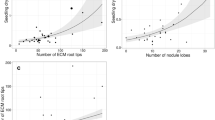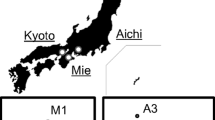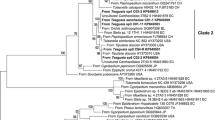Abstract
We explored the diversity of mycorrhizal fungi associated with Monotropastrum humile in the central part of Japan's main island. We collected 103 M. humile individuals from 12 sites with various forest types. We analyzed the DNA sequences of the internal transcribed spacer region from fungal and plant nuclear ribosomal DNAs to assess the genetic diversity of the fungi associated with M. humile roots and to position the plant with respect to known Monotropoideae groups, respectively. The plants formed a monophyletic clade with other members of M. humile but were separated from M. humile var. glaberrimum and other monotropes (97% bootstrap support). Of the 50 fungal phylotypes, 49 had best matches with the Russulales, and the other had highest similarity with the Thelephoraceae. Our phylogenetic analysis suggests that M. humile roots have a highly specialized association with fungal partners in the Russulaceae. Moreover, a few fungal phylotypes from the M. humile roots had positions neighboring those from Monotropa uniflora roots. These results indicated that the genetic diversity of mycorrhizal fungi of M. humile was highly specific to the Russulaceae, but with high diversity within that family, and that the fungi associated with M. humile differ from those associated with M. uniflora.


Similar content being viewed by others
References
Altschul SF, Madden TL, Schaffer AA, Zhang J, Zhang Z, Miller W, Lipman DJ (1997) Gapped blast and PSI-blast: a new generation of protein database search programs. Nucleic Acids Res 25:3389–3402
Begerow D, Nilsson H, Unterseher M, Maier W (2010) Current state and perspectives of fungal DNA barcoding and rapid identification procedures. Appl Microbiol Biotechnol 87:99–108
Bidartondo MI (2005) The evolutionary ecology of myco-heterotrophy. New Phytol 167:335–352
Bidartondo MI, Bruns TD (2001) Extreme specificity in epiparasitic Monotropoideae (Ericaceae): widespread phylogenetic and geographical structure. Mol Ecol 10:2285–2295
Bidartondo MI, Bruns TD (2002) Fine-level mycorrhizal specificity in the Monotropoideae (Ericaceae): specificity for fungal species groups. Mol Ecol 11:557–569
Bidartondo MI, Bruns TD (2005) On the origins of extreme mycorrhizal specificity in the Monotropoideae (Ericaceae): performance trade-offs during seed germination and seedling development. Mol Ecol 14:1549–1560
Björkman E (1960) Monotropa hypopitys L.—an epiparasite on tree roots. Physiol Plant 13:308–327
Bruns TD, Read DJ (2000) In vitro germination of non-photosynthetic, myco-heterotrophic plants stimulated by fungi isolated from the adult plants. New Phytol 148:335–342
Cullings KW, Szaro T, Bruns TD (1996) Evolution of extreme specialization within a lineage of ectomycorrhizal epiparasites. Nature 379:63–66
Duddridge JA, Read DJ (1982) An ultrastructural analysis of the development of mycorrhizas in Monotropa hypopitys L. New Phytol 92:203–214
Felsenstein J (1985) Confidence limits on phylogenies: an approach using the bootstrap. Evol Int J Org Evol 39:783–791
Gardes M, Bruns TD (1993) ITS primers with enhanced specificity for basidiomycetes: application to the identification of mycorrhizae and rust. Mol Ecol 2:113–118
Horton TR (2002) Molecular approaches to ectomycorrhizal diversity studies: variation in ITS at a local scale. Plant Soil 244:29–39
Imamura A, Kurogi S (2003) Difference in monotropoid mycorrhiza formation between Monotropastrum globosum and its forma roseum. Mycoscience 44:63–65
Ishida TA, Nara K, Hogetsu T (2007) Host effects on ectomycorrhizal fungal communities: insight from eight host species in mixed conifer–broadleaf forests. New Phytol 174:430–440
Kasuya MCM, Masaka K, Igarashi T (1995) Mycorrhizae of Monotropastrum globosum growing in a Fagus crenata forest. Mycoscience 36:461–464
Katoh K, Toh H (2008) Recent developments in the MAFFT multiple sequence alignment program. Brief Bioinform 9:286–298
Kirk PM, Cannon PF, Minter DW, Stalpers JA (eds) (2008) Dictionary of the fungi, 10th edn. CAB International, Wallingford
Kitamura S, Mutata G, Hori M (1975) Coloured illustrations of herbaceous plants of Japan (Sympetalae). Hoikusha, Osaka
Leake JR (1994) The biology of myco-heterotrophic (“saprophytic”) plants. New Phytol 127:171–216
Leake JR, McKendrick SL, Bidartondo M, Read DJ (2004) Symbiotic germination and development of the myco-heterotroph Monotropa hypopitys in nature and its requirement for locally distributed Tricholoma spp. New Phytol 163:405–423
Lutz RW, Sjolund RD (1973) Monotropa uniflora: ultrastructural details of its mycorrhizal habit. Am J Bot 60:339–345
Massicotte HB, Melville LH, Peterson RL (2005) Structural features of mycorrhizal associations in two members of the Monotropoideae, Monotropa uniflora and Pterospora andromedea. Mycorrhiza 15:101–110
Massicotte HB, Melville LH, Tackaberry LE, Peterson RL (2007) Pityopus californicus: structural characteristics of seed and seedling development in a myco-heterotrophic species. Mycorrhiza 17:647–653
Massicotte HB, Melville LH, Peterson RL, Tackaberry LE, Luoma DL (2010) Structural characteristics of root-fungus associations in two mycoheterotrophic species, Allotropa virgata and Pleuricospora fimbriata (Monotropoideae) from southwest Oregon, USA. Mycorrhiza 20:391–397
Matsuda Y, Hijii N (1998) Spatiotemporal distribution of fruit bodies of ectomycorrhizal fungi in an Abies firma forest. Mycorrhiza 8:131–138
Matsuda Y, Hijii N (1999) Characterization and identification of Strobilomyces confusus ectomycorrhizas on Momi fir by RFLP analysis of the PCR-amplified ITS region of the rDNA. J For Res 4:145–150
Matsuda Y, Hijii N (2004) Ectomycorrhizal fungal communities in an Abies firma forest, with special reference to ectomycorrhizal associations between seedlings and mature trees. Can J Bot 82:822–829
Matsuda Y, Yamada A (2003) Mycorrhizal morphology of Monotropastrum humile collected from six different forests in central Japan. Mycologia 95:993–997
Nei M, Kumar S (2000) Molecular evolution and phylogenetics. Oxford University Press, New York, 333 pp
Robertson DC, Robertson JA (1982) Ultrastructure of Pterospora andromedea Nuttall and Sarcodes sanguinea Torrey mycorrhizas. New Phytol 92:539–551
Ryberg M, Kristiansson E, Sjökvist E, Nilsson RH (2009) An outlook on the fungal internal transcribed spacer sequences in GenBank and the introduction of a Web-based tool for the exploration of fungal diversity. New Phytol 181:471–477
Selosse MA, Roy M (2009) Green plants that feed on fungi: facts and questions about mixotrophy. Trends Plant Sci 14:64–70
Selosse MA, Richard F, He X, Simard SW (2006) Mycorhizal networks: des liaisons dangereuses? Trends Ecol Evol 21:621–628
Tamura K, Dudley J, Nei M, Kumar S (2007) MEGA4: Molecular Evolutionary Genetics Analysis (MEGA) software version 4.0. Mol Biol Evol 24:1596–1599
Tedersoo L, Suvi T, Larsson E, Kõljalg U (2006) Diversity and community structure of ectomycorrhizal fungi in a wooded meadow. Mycol Res 110:734–748
Tedersoo L, Pellet P, Kõljalg U, Selosse MA (2007) Parallel evolutionary paths to mycoheterotrophy in understorey Ericaceae and Orchidaceae: ecological evidence for mixotrophy in Pyroleae. Oecologia 151:206–217
Trudell SA, Rygiewicz PT, Edmonds RL (2003) Nitrogen and carbon stable isotope abundances support the myco-heterotrophic nature and host-specificity of certain achlorophyllous plants. New Phytol 160:391–401
Tsukaya H, Yokoyama J, Imaichi R, Ohba H (2008) Taxonomic status of Monotropastrum humile, with special reference to M. humile var. glaberrimum (Ericaceae, Monotropoideae). J Plant Res 121:271–278
Wallace GD (1975) Studies of Monotropoideae (Ericaceae): taxonomy and distribution. Wasmann J Biol 33:1–88
White TJ, Bruns TD, Lee SB, Taylor JW (1990) Amplification and direct sequencing of fungal ribosomal RNA genes for phylogenetics. In: Innis MA, Gelfand DH, Sninsky JJ, White TJ (eds) PCR protocols—a guide to methods and applications. Academic, New York, pp 315–322
Yamada A, Katsuya K (2001) The disparity between the number of ectomycorrhizal fungi and those producing fruit bodies in a Pinus densiflora stand. Mycol Res 105:957–965
Yamada A, Kitamura D, Setoguchi S, Hashimoto Y, Matsuda Y, Matsushita N, Fukuda M (2008) Monotropastrum humile var. humile is associated with diverse ectomycorrhizal Russulaceae fungi in Japanese forests. Ecol Res 23:983–993
Yang S, Pfister DH (2006) Monotropa uniflora plants of eastern Massachusetts form mycorrhizae with a diversity of russulacean fungi. Mycologia 98:535–540
Yokoyama J, Fukuda T, Tsukaya H (2005) Molecular identification of the mycorrhizal fungi of the epiparasitic plant Monotropastrum humile var. glaberrimum (Ericaceae). J Plant Res 118:53–56
Young BW, Massicotte HB, Tackaberry LE, Baldwin QF, Egger KN (2002) Monotropa uniflora: morphological and molecular assessment of mycorrhizae retrieved from sites in the Sub-Boreal Spruce biogeoclimatic zone in central British Columbia. Mycorrhiza 12:75–82
Acknowledgments
We thank Naoto Oonishi (Taiki town office, Mie Prefecture) and Naoya Yamano (The Japan Serow Center in Mie Prefecture) for providing information on the plant materials, the members of the Laboratory of Forest Pathology and Mycology, Mie University, for their assistance in the field, and two anonymous reviewers for their insightful suggestions on this manuscript. This study was supported in part by Grants-in-Aid for Scientific Research from the Japan Ministry of Education, Science, Sports and Culture to YM (20651061 and 22688011).
Author information
Authors and Affiliations
Corresponding author
Electronic supplementary material
Below is the link to the electronic supplementary material.
Table S1
(DOC 18 kb)
Rights and permissions
About this article
Cite this article
Matsuda, Y., Okochi, S., Katayama, T. et al. Mycorrhizal fungi associated with Monotropastrum humile (Ericaceae) in central Japan. Mycorrhiza 21, 569–576 (2011). https://doi.org/10.1007/s00572-011-0365-3
Received:
Accepted:
Published:
Issue Date:
DOI: https://doi.org/10.1007/s00572-011-0365-3




